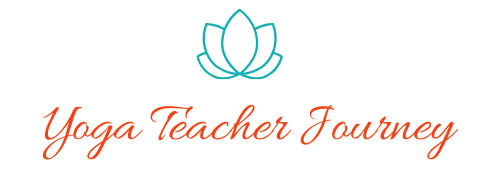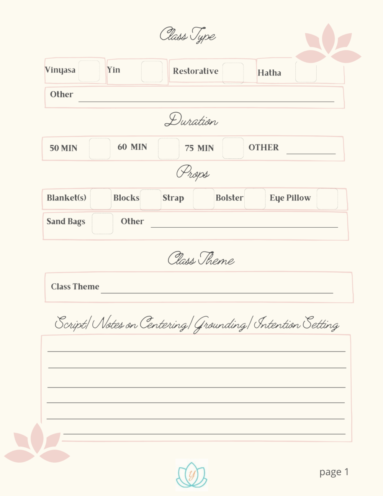Let’s face it. It can sometimes feel stressful planning for your next yoga class. You taught what you thought were awesome classes this week with a theme that was spot on and well received. Now you’re starting from scratch once again. You want to deliver consistent, comprehensive classes each week and sometimes it can be overwhelming. Follow the simple steps below to make this preparatory period much more easeful.
STEP 1 – GATHER INSPIRATION
Inspiration for your next class can come from external sources, such as:
- social media (i.e., Instagram, Facebook, YouTube, etc.) or from books you are reading such as Gabrielle Harris’ The Language of Yin (even if you’re not teaching Yin), or The Inspired Yoga Teacher, or Yoga Teacher Journey’s Themes and Sequences Workbook! Non yoga books offer inspiration too. Maybe something like Judith Orloff’s Thriving as an Empath, or Melody Beattie’s Journey to the Heart.
- Inspiration can be derived from seasons, holidays, moon phases, time changes, equinoxes, solstices, poems, yoga philosophy (8 limbs, yoga sutras, mythology, chakras, koshas, ayurveda), anatomy, physiology – or something you learned from a teacher training or from a class led by another yoga teacher (there’s no shame in this – put it in your own words and make it yours).
Internal sources can result in inspiration as well. What are these you ask? I’m so glad you did!
- This inspiration comes from your own personal life situations, experiences, feelings, emotions, interactions with other humans, nature, animals, and things. Sometimes the external sources blend with your own experiences and emotions and come together to form a truly authentic theme. Since these themes are personal to you, they tend to be even more appealing to your students since they make you more human, more relatable – sharing an inside peak at your more vulnerable side.
For more theme inspiration, read How to Theme a Yoga Class.
STEP 2 – GET ON YOUR MAT
I’ll pause here for a moment and just say that “getting on your mat” can also be Step 1. Meaning, sometimes when you arrive on your mat and begin moving your body, inspiration just comes to you. Just as with Step 1, there is a wide array of options in Step 2. You can think of these two steps as a Charcuterie board of theme options from which to choose. If olives don’t suit you this week, there’s plenty of cheese! So, if you are planning your next class and you haven’t received inspiration from another source, get on your mat and see what comes.
Pro Tip: When you’re just not feeling it from any of the sources above, choose something you’ve already done! Yes, it’s okay and actually good to repeat themes and sequences. Repetition is good for learning. Even if you have the same students, they will appreciate the opportunity to assimilate the information once more. Second time around, they may learn something new. This is especially true for themes like the chakras, yoga sutras, the 8 limbs and other yoga philosophy.
STEP 3 – PLAN YOUR SEQUENCE
Regardless of the style of yoga you’re teaching, you’ll want to choose postures that complement the theme of the class. Things to consider when planning your sequence:
The Theme of the Class
- For example, if you are teaching a class on Ahimsa (non-harming) or Maitri (loving-kindness), you may consider planning your sequence around heart-opening postures. Conversely, if your theme is about Letting Go, you may choose detoxifying postures such as twists, or, fiery, purifying core work. Honoring the Full Moon? Add a few moon salutations into your flow. Whatever it is, find a way to connect asana to the theme and ultimately something students can carry with them when they leave the mat.
The Demographics of Your Class
- Who are your students? Do they enjoy a workout and challenge – or do they prefer to take it slower and more meditative? If you have a mix or it is unknown, you may need to balance out your choice of postures and options.
The Time of Day
- Morning classes tend to be more energizing, while evening classes should leave people feeling a little more relaxed.
Level of Class
- Is it all levels, level one, advanced? This should help determine the postures you include in your sequence and maybe a peak posture. Even for level one however, it’s nice to offer an option or challenge posture should students choose to try it. Remember to always offer modifications and variations.
Duration of Class
- Obviously, a sixty-minute class will include fewer postures than a seventy-five-minute class. Plan to allow adequate time for warm-up and cool-down postures, plus a proper Savasana!
See also: To Peak or Not to Peak – Sequencing Tips for New Yoga Teachers
STEP 4 – WRITE DOWN YOUR SCRIPT AND SEQUENCE PLAN
When new to planning and teaching your classes, writing down your script and sequence is a comforting and necessary step. This helps solidify it in your mind and gives you a guide to use while teaching the class. While in this phase you may find this Yoga Class Planning Template a handy tool. It’s being offered at a discount in honor of this post!
Several years into teaching, I still use notes (a script) to deliver my themes, but no longer use them for my sequences. It took some time before I was comfortable not having my sequence with me in print, but I knew it was time when I was no longer looking at the notes during class. It would actually disrupt my train of thought and make it awkward for me, if I did refer to them.
Be ready to let go of writing it down! It WILL come with time. See Yoga Journal’s 6 Ways to Plan an Inspiring Yoga Class for more tips.
STEP 5 – PRACTICE YOUR SEQUENCE
Once you have planned your theme and sequence it’s time to get back on your mat and practice! You will find that muscle memory works great for memorizing your sequence. At this point:
- You are comfortable with your theme
- You have documented your sequence
- You know your peak pose or anatomy you’re emphasizing
- You have an idea of who your audience might be
As you move into the various asanas and transitions, keep all of this in mind as you think of how you will cue your students and deliver your yoga teacher wisdom.
Once you begin practicing, focus on the key elements of your class as noted above. Practice your sequence at least two times to embed it deeply in muscle memory.
FINAL NOTES
As time goes on, you may find it less necessary to plan ahead in such detail. You won’t quite feel the need for the comfort you once did, of having a meticulously planned class. After all, there will be times you plan and practice every detail, students arrive, class starts and everything you planned goes out the window. This is all part of being a professional yoga teacher – being able to adapt and adjust your plan based on who enters your class.
But it’s all good! Be authentic, deliver the message of your theme, teach the class at the level needed, relax and enjoy!





